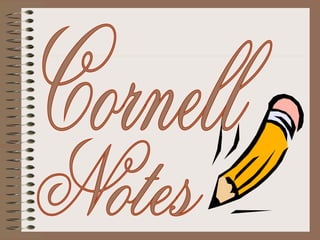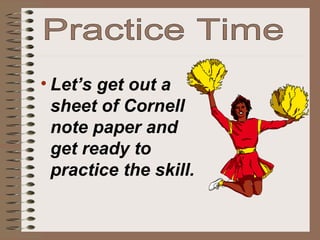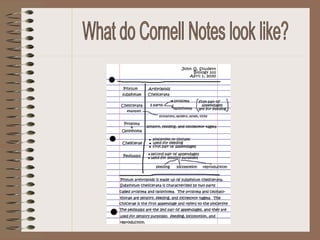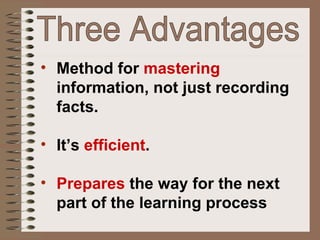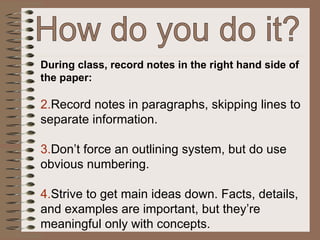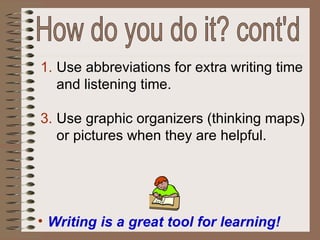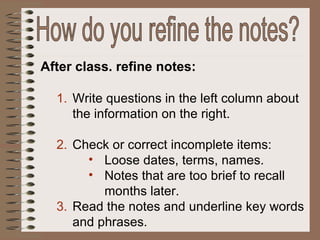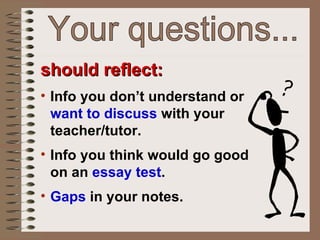Cornell notes
- 2. How did you learn the skill of note taking? How did this skill contribute to your success? Has anyone formally taught you how to take notes?
- 3. Practice Time LetŌĆÖs get out a sheet of Cornell note paper and get ready to practice the skill.
- 4. What do Cornell Notes look like?
- 5. Assignment In the large, right hand column , take notes like you normally would. You may use any style of note-taking you wish: outline format, narrative format, symbols, abbreviations, etc.
- 6. History of Cornell Notes Developed in 1949 at Cornell University by Walter Pauk. Designed in response to frustration over student test scores. Meant to be easily used as a test study guide . Adopted by most major law schools as the preferred note taking method.
- 7. Note Taking Tips Speaker says : ŌĆ£Hippocrates, a Greek who is considered to be the Father of modern medicine, was Born on the island of Cos in 460 B.C.ŌĆØ Notes say : ŌĆ£Hippocrates (Gr.) Father of med. B. Cos 460BCŌĆØ
- 8. Good notes allow you to help each other problem solve . Good Notes help you organize and process data and information. Helps you recall by getting you to process your notes 3 times. Why Cornell Notes?
- 9. Method for mastering information, not just recording facts. ItŌĆÖs efficient . Prepares the way for the next part of the learning process Three Advantages
- 10. During class, record notes in the right hand side of the paper: Record notes in paragraphs, skipping lines to separate information. DonŌĆÖt force an outlining system, but do use obvious numbering. Strive to get main ideas down. Facts, details, and examples are important, but theyŌĆÖre meaningful only with concepts. How do you do it?
- 11. Use abbreviations for extra writing time and listening time. Use graphic organizers (thinking maps) or pictures when they are helpful. How do you do it? cont'd Writing is a great tool for learning!
- 12. Example (Diagram copied during lecture ) (Questions about it ) How do the ticks find the cattle? Why donŌĆÖt the ticks usually kill their host? How could tick infestations in cattle impact humans?
- 13. After class. refine notes: Write questions in the left column about the information on the right. Check or correct incomplete items: Loose dates, terms, names. Notes that are too brief to recall months later. Read the notes and underline key words and phrases. How do you refine the notes?
- 14. Read underlined words and write in recall cues in the left-hand column (key words and very brief phrases that will trigger ideas/facts on the right.) These are in addition to the questions. Write a reflective paragraph about the notes at the bottom of the page. If possible, compare notes with a study buddy. How do you refine the notes? cont'd
- 15. Recite notes three ways: Cover up the right side of the page/ Read the questions. Recite information as fully as possible. Uncover the sheet and verify information frequently (single, most powerful learning tool)! What are the ways to recite notes?
- 16. Reflect on the organization of all the lectures. Overlap notes and read and recall cues from the left side. Study the progression of the information. This will stimulate categories, relationships, inferences, personal opinions/experiences. Record all of these insights! REFLECTION = KEY TO MEMORY!!! Review by reciting, reflecting, and reading insights. What are the ways to recite notes? cont'd
- 17. The system in brief: Record lectures in the main column. Within 8 hours, read over notes to fill in gaps and to make notes more legible. Identify main ideas and write questions in the left-hand column based on main ideas. Recite by covering main column and expanding on recall issues. Then verify. Write a summary at the bottom of the page. Review your notes regularly. Short, fast, frequent reviews will produce better understanding. What are the six steps of this system?
- 18. Compare notes with your partner. Talk about what you wrote and why. Look for gaps and missed info . Both partners should feel free to add to their notes. Whenever you add to you notes, try to use a different color. With your partner, create questions in the left hand column. Instructions
- 19. should reflect: Info you donŌĆÖt understand or want to discuss with your teacher/tutor. Info you think would go good on an essay test . Gaps in your notes. Your questions...
- 20. The Summary ŌĆō On your own, in the space provided at the bottom of the page, complete a 3 or 4 sentence summary of what you wrote in your notes. Homework
